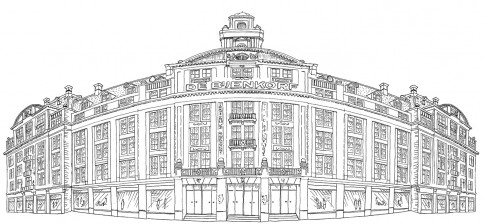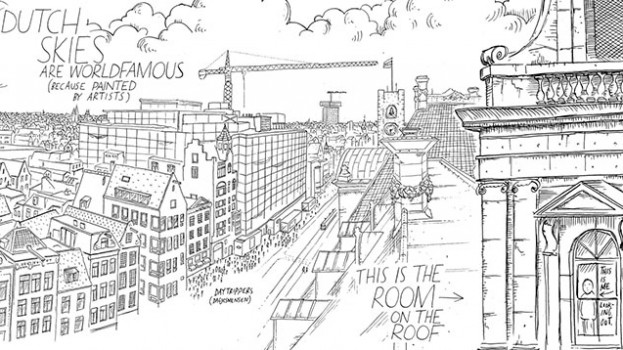“In VR you are being watched while you are watching something”
Drawing Room won the IDFA DocLab Award for Digital Storytelling. How do you make an awardwinning project? Jan Rothuizen and developer Harm van de Ven on their creative process.
And the winner of the IDFA storytelling award is…
“It’s incredible. It’s the first time that I created something like this”, Jan Rothuizen says the day after winning, still a bit amazed.
Birth of Drawing Room
“My drawings are about space and exploring the surroundings so it already feels a little bit like virtual reality”, Jan says. “I had the urge to create a project in VR.” For an open assignment he ended up in a little room with a gorgeous view at the top of De Bijenkorf, a big shopping mall in the centre of Amsterdam. “The place is beautiful and not open to the public. So, it felt like an ideal surrounding for a VR project.” Drawing Room was born.
No script, no story
Jan: “I’m in the selection committee of a media fund and the applications I usually see have detailed plans for the production. That’s a good thing but sometimes, I learned, it actually works to work without a plan. Like we did. ”
“Working without a plan was characteristic for the whole process. We just started working. The script was delayed every time. Sometimes I found that very difficult because eventually there had to be a story. I work with stories, but not in a chronological manner. For this project time became important in the story. We had to search for a good way to make that possible.”
They didn’t have a detailed plan. What they had was a team: interactive director Sara Kolster and Harm van de Ven from Zesbaans, a new media initiative. Harm: “It was like a promise: Jan Rothuizen en VR. It had to be good.”
And even better: they had funding. “We are very lucky that VR is very hot at the moment. De Bijenkorf was very willing to increase the budget, even when there wasn’t a plan.”
Limit the space
Leaning by making. Jan: “At first we wanted to recreate the whole shopping mall in VR. The escalators, the people, all the floors, everything. Very quickly we realised it didn’t work. Our theoretical idea needed a practical plan.”
Harm: “We had to limit the space. We downsized from the whole mall to only five rooms. But we got stuck. What is going to happen in those five rooms? We had no idea. Then we talked about what would happen if we only took one elevator.” Jan: “Finally we decided that it was best to only use the tower room.”

‘My voice was terrible’
Jan: “How do you tell the story in VR? A few projects inspired me. One was Kiya from Nonny de la Peña. For me it was a very touching project. She changed between different scenes like you are watching a movie. It surprised me how easily you understand that language. The other project was made by Oscar Raby. He used a really compelling narrative voice.”
Harm: “We felt Drawing Room needed a voice.” It needed a lot of tinkering before it was right. Jan: “It’s like music; you can feel when it’s right. First we tried it with my voice. It was terrible. We realized how important a voice is and decided we needed an actor. I found the voice of Drawing Room while listening to the radio. I immediately thought it needed to be this man: Eelco Smits.”
Multidisciplinary team
“I hadn’t worked with a multidisciplinary team before. At first I thought it was enough to only draw the lines and Harm could just create the building”, Jan says laughing.
Nope, it doesn’t work like that. Creating a 3D world from 2D drawings is hard work. The team had skills in interaction design, 3D modelling, storytelling, audio design and a coder. We used Unity to build the Drawing Room. Harm: “Everything is unique in the room. When you make something in 3D you can re-use the table for example. Not if you work with the drawings of Jan. It wouldn’t do them justice.”
Harm: “When we decided that there would be five scenes in the tower room it became clear that we needed drawings for each scene of every perspective. We wanted to keep the style of Jan intact. So Jan needed to draw a lot, we regularly called him to ask for new drawings.”
Jan: “It was hard because you want everything to be consistent. I was constantly improving the drawings, drawing them over and over. I also sketched everything tree of four times, because you needed to see everything from different angles.”
Testing is key
Jan: “We used user testing because we didn’t have answers to a lot of questions. Are the scenes not too long or short? Is there enough space between the sentences? How well do users read the text? What kind of clues do they need and how many?” Harm: “We changed a few things after these tests.”
Tinkering with VR does come with its own set of challenges, Jan noticed. “The big drama in VR is that you can’t take notes while you have the goggles on your head.” Harm: he tried, but it didn’t work.
Seeing it in VR for the first time was very special. Harm: “It was very funny because Jan had the goggles on and grabbed the table in his imagination.” Jan: “That was really weird because someone is in your imagination at that moment.”

